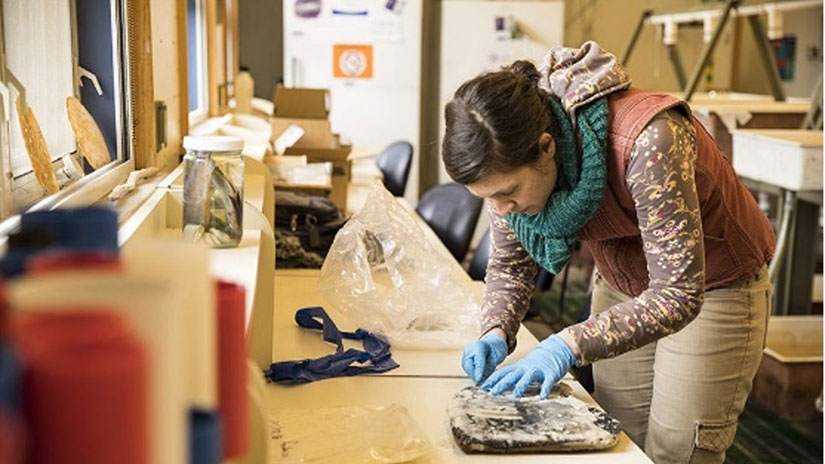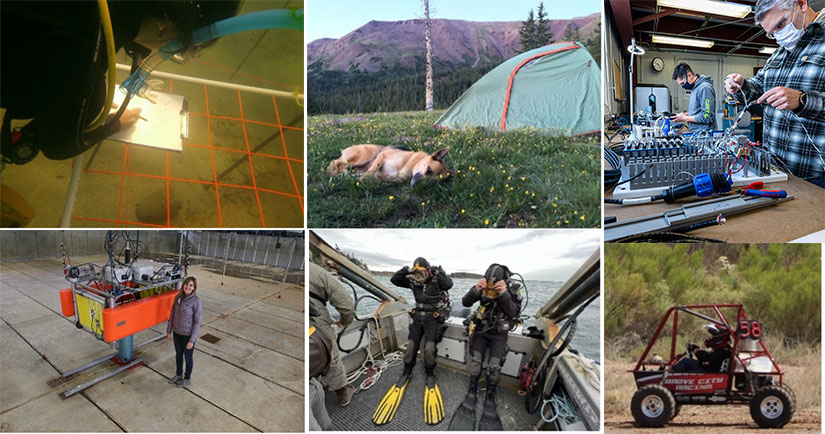Why You Might Love a Career in Marine Energy
In a Recent Career Panel, Professionals Shared Why They Fell for This Nascent Field of Renewable Energy (and Why They Hope You Do, Too)

Some get to watch sunsets on the beach. Some visit oyster farms. Some forge wires, gears, and metal into buoys, paddles, and snakes. Some poke and stretch materials. Some build tools to protect seals and whales. And some unearth knowledge from dense data and build virtual replicas of the real world.
One has a caramel-colored dog named Pumpkin.
Who are these eclectic people? Based on their varied work, you might think they come from equally varied fields. But no—these researchers all work in one, less-well-known area of renewable energy: marine energy, which is clean energy generated from the power pulsing through our rivers and oceans. And they all agree on one thing: They love their wonderfully varied jobs.
“It’s not the same for more than a few days in a row,” said Justin Panzarella, an engineering intern at the National Renewable Energy Laboratory (NREL).
On Feb. 7, 2024, Panzarella and four other marine energy professionals joined a Marine Energy Career Panel hosted by NREL and the Pacific Northwest National Laboratory (PNNL) and funded, in part, by the U.S. Department of Energy’s Water Power Technologies Office (WPTO). Each of the five panelists currently works at one of three national laboratories: NREL, Pacific Northwest National Laboratory, and Sandia National Laboratories. The five also represent the vast diversity of research areas, skill sets, and day-to-day work available in marine energy (or even the broader field of offshore energy).
And they are hungry for more colleagues.
“We definitely need more smart people,” said Andrew Simms, a marine energy technician at NREL.
Marine energy devices, along with their offshore counterparts, like offshore wind turbines and floating solar panels, could significantly boost the country’s renewable energy supplies. Offshore, winds blow faster, so wind turbines can be bigger and more efficient. In the United States, powerful ocean waves, currents, and tides and even river currents carry enough energy to meet nearly 60% of the country’s electricity needs. We cannot access all that power, but even just a small percentage could help power the blue economy—delivering clean energy to island and coastal communities, offshore seafood farms, and marine research—or even the U.S. power grid.

But to tap that available energy—and do so safely and responsibly—the country needs a substantial enough workforce. A 2021 report found that the offshore wind energy industry must significantly grow its workforce to reach the country’s clean energy goals. The marine energy industry faces a similar challenge. Marine energy is an emerging field; today, technology developers and researchers are still searching for the most efficient, cost-effective device designs. In short, there are a good number of challenges the industry must overcome before any homes can be powered by the ocean.
But for one of the panelists, that newness is a bonus: “It’s still a nascent industry, but that brings a lot of opportunity for creativity,” said Molly Grear, an ocean engineer at PNNL.
Grear dabbled in ocean policy before landing at PNNL where she studies how marine energy devices might impact marine wildlife and ecosystems. There, she can blend her various loves: marine biology, community engagement (understanding social impacts and challenges), and engineering. She also gets to try different things every day. One day, for example, she could be in the lab, researching how animals might interact with underwater turbines. (“We don’t know enough about whale eyesight to know if they can see it!” Grear said). And the next day? “You’re climbing on something in the ocean,” she said.
The other panelists found their ways to marine energy through a variety of experiences: fisheries in France, wind farms in Germany, Baja cars (which are basically more sophisticated versions of go-karts) and a wave energy prototype sunk in Lake Erie, and a business degree and penchant for climbing wind turbines.
Some of the panelists are expert engineers. But others come from backgrounds in biology, economics, computer science, or environmental policy. And because the work can span everything from project development to environmental monitoring, manufacturing and supply chains, ports and staging, maritime construction, and operations and maintenance, few of the panelists are contained to an office. Some days, they might work in software, simulating the ocean or modeling prototypes. Other days, they might interview community members, drive a forklift, visit a wave tank, or hop on a boat to collect data on a prototype. Simms, a technician at NREL, has traveled to beaches in North Carolina, Texas, California, and Hawaii.
“The beach is a bit too cold in my opinion, but there are really nice sunsets,” said Lysel Garavelli, a research scientist at PNNL in Seattle, Washington, who originally studied biology and ecology and helped manage fisheries in France. At the time, she didn’t realize how easily she could transfer her skills to marine energy—or even that marine energy existed. Now, Garavelli does much of her work on a computer, but she also recently tagged and released fish in the Columbia River to see if they survived their journey through a dam.
The panelists also offered advice on how others, including young students or folks working in comparable sectors, like offshore energy, could transition into marine energy jobs. Many started their careers as interns, research associates, or postdoctoral scholars at one of the national laboratories (and many ended up in full-time jobs by the time that position ended).
WPTO and the national laboratories also provide educational resources and programs, like the new marine energy career map, to help people find their way into the field. For example, undergraduate and graduate students can compete in the Marine Energy Collegiate Competition or earn a fellowship to gain firsthand experience in the industry. Graduate students can apply to join the Oak Ridge Institute for Science and Education Marine Energy Graduate Student Research Program. And the National GEM Consortium, which aims to increase the number of underrepresented students in engineering and science who pursue advanced degrees, offers fellowships for minority students to spend their summers at a national laboratory or similar organization.

“GEM is a really cool opportunity to engage students who may or may not have had any exposure to water power or marine energy and get them in the door at the national labs,” said Arielle Cardinal, a project manager for NREL’s water power program who hosted the career panel.
Simms, who joined NREL after earning his bachelor’s degree in business, initially worked as a marine energy technician, helping build and test novel technologies. But now, he is earning a master’s degree in data science while continuing to work full-time at the laboratory. With his degree, he will be able to do more data analysis and machine learning, helping to improve those same prototypes. NREL not only supports his decision to go back to school; the laboratory is also paying for his tuition (many other laboratories offer the same benefit).
Despite taking entirely different, often winding paths to marine energy, all the panelists agreed that they are happy they got there.
“I thought I’d be there for a few years, and here I am a decade later,” said Kelley Ruehl, a marine energy modeler at Sandia National Laboratories. “If I wasn’t happy, I would have left.”
Watch the recording of the Marine Energy Career Panel to hear more about how the panelists built their careers, or apply for one of many career development opportunities. Or find more STEM education resources on the Portal and Repository for Information on Marine Renewable Energy and Tethys webpages.
And subscribe to the NREL SPLASH newsletter for STEM updates and the NREL water power newsletter, The Current, for water power updates.
Last Updated May 28, 2025
